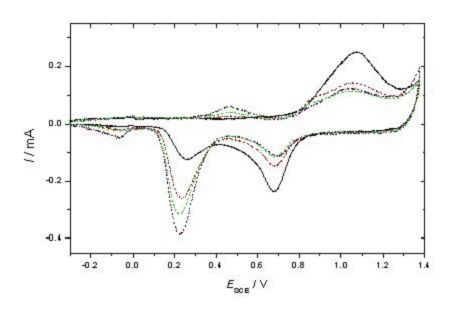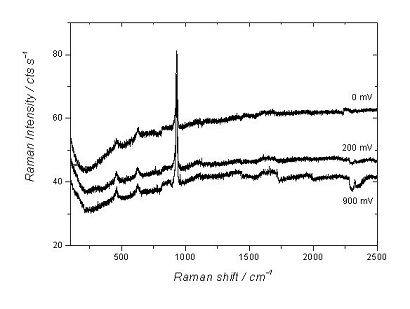Spectroelectrochemical Studies of 4-Mercaptophenol adsorbed on Gold Surfaces
Most commonly adsorbate layers (including self-assembled monolayers (SAMs)) of -SH-substituted molecules (e.g.thiolates) on gold surfaces are formed by adsorption from the respective solutions. 4-MP adsorbed on a gold electrode from dilute ethanolic solutions yields densely packed monolayers. Although verification is not simple and straightforward it has been proposed, that these molecules can self-assemble forming compact layers bonded through the S-atom with the aromatic ring in an upright position.This modified electrode has a behavior different from that of a bare gold electrode. These monolayers show typical characteristics of self-assembled monolayers(SAMs). The use of the S-Au bond has been the primary basis for the attachment of molecules onto electrodes for the emerging field of molecular electronics [1].
 |
CV of a bare gold electrode (dash dot purple) and modified gold electrode (few cycles), 0.1 M KClO4, nitrogen purged, scan rate 0.1 mV/s in the range of 0.3 < Esce < 1.35 V.
The aim of this project from is to charactrize the structure of monolayers, the type and the strength of the interaction between the aromatic thiol and gold substrate, and to investigate the interaction between a substitutent group in the para position with cations (Ferric and copper ions) by combination of electrochemical ( Cyclic voltammetry , impedance measrements) and spectroscopic methods (in situ enhanced surface Raman spectroscopy (SERS) ). Cyclic voltammetry is a powerful and fast method for evaluating adlayers, it has been employed throughout this investigation many times.
 |
SER spectra of modified gold electrode with 4-MP in nitrogen-purged 1M HClO4 solution at positive potential range,
resolution < 2cm-1, ![]() 0=647.1 nm, P0= 100 mV
0=647.1 nm, P0= 100 mV
Another important method that will be used for investigation of SAMs is Surface enhanced Raman scattering (SERS) that was first observed [2] in 1974 and identified [3] in 1977. This powerful spectroscopic method is used throughout this investigation for adsorbant aromatic thioles on Au electrode which, under potential control, undergo numerous oxidation and reduction cycles in an electrochemical cell to charactrize the adlayers.
REFERENCES :
| 1: | C. Joachim, J. K. Gimzewski, A. Avram, Nature 2000, 408 (6812), 541548. |
| 2: | M. Fleischmann, P.J. Hendra and A.J. McQuillan : Raman Spectra of Pyridine Adsorbed at a Silver Electrode, Chem. Phys.Lett. 26, 163 (1974). |
| 3: | D.L. Jeanmaire and R.P. Van Duyne, : surface Raman Spectroelectrochemistry. I. Heterocyclic, Aromatic, and Aliphatic Amines Adsorbed on the Anodized Silver Electrode, J. Electronal. Chem. 84, 1 (1977). |
